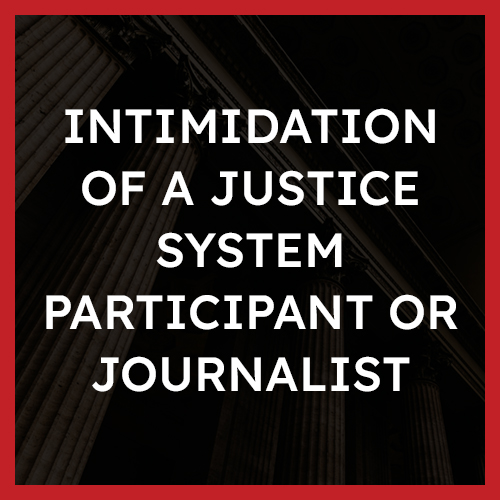Intimidation of a Justice System Participant or Journalist (s. 423.1) Laws in Canada
 What is Intimidation of a Justice System Participant or Journalist?
What is Intimidation of a Justice System Participant or Journalist?
Intimidation of a Justice System Participant or Journalist is an offence under Section 423.1 of the Criminal Code of Canada. This section includes all “justice system participants”, such as police and peace officers, judges and justices, crown prosecutors, government officials, court administrators, witnesses, and confidential informants.
Examples
Some examples of the offence of Intimidation of a Justice System Participant or Journalist may include:
- A person threatens a crown prosecutor, who had been assigned to prosecute a matter against a close friend or family member to that person and tells them to drop charges.
- A person threatens to harm a journalist if they report on a criminal organization that is in the public interest to be reported, and intimidates the journalist from proceeding to publish a news story on the subject.
- A person threatens a witness of a crime, and causes them to be in fear to provide testimony to the matter in court,
- A person threatens a juror and causes them fear to perform their duties on a jury.
Defences
A strong defence to a charge of intimidation of a justice system participant or journalist will vary depending on the circumstances of what occurred.
However, some defences may be:
- The accused made an honest mistake or error. This may include mistaken belief that they could discuss a matter with a justice system participant or journalist, however, conveyed threats, or were perceived to convey threats
- The accused did not intend to provoke a state of fear in the justice system participant or journalist by their actions
- The identity of the accused, or date, time, or location which the offence occurred were not properly established by the police.
- There is a lack of material information which supports the allegation that the accused intended to provoke a state of fear. This may include a lack of documented evidence, physical evidence, or witness testimony.
- Duress: if the accused was under considerable duress, or there were circumstances which may support this defence, an accused person should discuss this with their lawyer.
- The Charter: if evidence was obtained through an unreasonable search or seizure, such evidence can be excluded. Again, it is advisable to discuss the evidence seized and the totality of the circumstances with a lawyer.
Punishment
The maximum penalty for a conviction under Section 423.1 is a term of imprisonment not exceeding a period of fourteen (14) years.
Whether you intend to plead guilty to a charge under section 423.1, it is important to consult a lawyer prior. There may be factors which apply to your punishment/sentencing which are relevant and important for consideration, which may result in a lesser punishment
Have you been charged with Intimidation of a Justice System Participant or Journalist?
Our experienced team of criminal defence lawyers is standing by to help you fight the charge. Contact us today for a free, no-obligation consultation to discuss the specifics of your case and craft a formidable defence.
Overview of the Offence
Fraudulent concealment is an offence under section 341 of the Criminal Code of Canada.
341 Every person who for a fraudulent purpose, takes, obtains, removes, or conceals anything is guilty of
(a) of an indictable offence and liable to imprisonment for a term of not more than two years; or
(b) an offence punishable on summary conviction
Section 341 is a dual/hybrid offence, which means the crown prosecutor can proceed by summary or by indictable offence.
Intimidation of a Justice System Participant or Journalist is an offence under section 423.1 of the Criminal Code of Canada. The section defines the offence as the use of violence, threatening to harm or cause damage to the property of, persistently or repeatedly following, a justice system participant or journalist, with the intention of provoking a state of fear, and impeding their ability to do their job. This section is designed to protect persons employed in the justice system and journalists from being able to complete their employment duties free from threats, fear, or intimidation.
In order for a person to be convicted of intimidation of a justice system participant or journalist in criminal court, the crown is required to prove their case beyond a reasonable doubt. The crown must also prove several elements of the offence, such as that a person engaged in conduct that was intended to provoke a state of fear.
Proving the offence should include: confirming the accused’s identity, the date(s) and time(s) in which the incident(s) occurred, the jurisdiction, that the accused intended to provoke a state of fear and ultimately impede the lawful execution of their duties. The presumption of innocence applies in that the accused is presumed innocent until convicted of the offence.
The Guilty Act (Actus Reus)
The actus reus for the offence of intimidation of a justice system participant of journalist is established by proof, beyond a reasonable doubt, of the following:
- The accused engaged in prohibited conduct such as violence, threats, or intimidation
The Guilty Mind (Mens Rea)
The mens rea for intimidation of a justice system participant or journalist is established by proof, beyond a reasonable doubt, of the following:
- The accused knowingly demonstrated an intention to provoke a state of fear in the person by engaging in this conduct
and
- The accused did so to impede them in their duties
Defences
How to beat a charge of intimidation of a justice system participant or journalist:
Each circumstance is different, and the best defence available is contextual based on the details. However, the following are some common defences that may be used against a charge of intimidation of a justice system participant or journalist.
Proving the identity of the accused:
There are several aspects to this defence, however, one may rely on whether there was evidence seized by the police, which directly implicates the accused. The accused’s identity, as well as the date, time, and location of the offence, are necessary for the crown to prove beyond a reasonable doubt.
Lack of Knowledge/Honest Mistake/No Mens Rea or Mental Intent:
Lack of knowledge may also be raised as a defence in some circumstances if the accused can prove that they did not know that they would, or intend to, provoke a state of fear in the justice system participant or journalist when the incident occurred. Additionally, if the accused did not know that the person was a justice system participant or journalist, then there is no mens rea or intent.
It is also necessary to prove that the accused did not have lawful authority to engage in communication or conversation, and intended to provoke a state of fear in order to impede them in their actions or the execution of their duties.
Lack of Actus Reus
The crown is required to prove beyond a reasonable doubt that the accused’s actions contributed to the state of fear. If the interaction occurred by way of chance encounter, and not as the result of the accused following, persisting, or seeking to intimidate the complainant, this may be a factor.
Ensuring the evidence was obtained lawfully
It is advisable to consult a lawyer in such circumstances, however, there may be circumstances where evidence was obtained from the accused person without their consent, and where they held a reasonable expectation of privacy. If this is the case, it is important to seek consultation from a lawyer to ensure that the accused’s rights under section 8 of the Canadian Charter of Rights and Freedoms were not violated. If they were, there have been circumstances where the courts have deemed the evidence seized in this manner inadmissible.
Evidence, and how it was seized, although always important to examine diligently, is especially so in circumstances where communications may have been made, electronically by email, text message, etc. For example, if a person is charged with intimidation of a justice system participant and information obtained from a laptop or cellular device was seized as evidence, it is important to determine the accused’s expectation of privacy in this context, and whether the police obtained warrants to search the devices, or were required to.
Punishments
The maximum penalty for a conviction under Section 423.1 is a term of imprisonment of up to 14 years.
Whether you intend to plead guilty to a charge under section 423.1, it is important to consult a lawyer prior. There may be factors which apply to your punishment/sentencing which are relevant and important for consideration, which may result in a lesser punishment.
Frequently Asked Questions
Is intimidation of a justice system participant or journalist an indictable offence?
Yes, under section 423.1 of the Criminal Code of Canada, it is an indictable offence.
Could I go to jail if convicted of intimidation of a justice system participant or journalist?
Yes, the maximum penalty, if convicted, is up to fourteen (14) years imprisonment.
What do I do if the police ask me about the intimidation of a justice system participant?
A consultation with a lawyer is strongly advised prior to answering any questions from the police. At Strategic Criminal Defence, a free consultation is offered through our contact information. Intimidation of a justice system participant or journalist is viewed by the courts as a very serious offence, as stated above, it is a straight indictable offence.
Published Decisions
R v. Bergeron, 2015 BCCA 177 (CanLII)
In this decision, the accused was found guilty of intimidation of a justice system participant after threatening and assaulting a crown prosecutor in Prince George, British Columbia. The trial judge concluded there was no doubt that the accused knew his actions would provoke a state of fear in the victims, as the accused had also made reference to the victim by accusing him of putting him in jail.
You can view the full decision here.
R v. Redgun, 2016 ABPC 236
The accused was convicted of intimidation of a justice system participant under section 423.1 of the Criminal Code. This occurred in Calgary, Alberta, where the accused was the parent of a person held in custody at the Calgary Remand Centre awaiting trial for serious charges, pertaining to an incident where a person was stabbed to death. While at a shopping centre in Calgary, the accused encountered a person who had provided witness testimony against her child in relation to the fatal stabbing. The accused made statements toward the witness, calling them a liar, and using profane and offensive language. Shortly after, the accused encountered the witness in the shopping centre parking lot and threatened to assault them, before following them back into the mall. Based on the totality of the circumstances, the accused was convicted of section 423.1. The accused had no prior criminal record and was ultimately sentenced to two years probation, and received a fine.
You can view the full decision here.
R v Wouters, 2017 ABPC 143
The accused was convicted of intimidation of a justice system participant under section 423.1 of the Criminal Code. This occurred in Calgary, Alberta, and the victim was the accused’s probation officer, who he had contact with by phone and left messages regarding a clerical error about one of his conditions of probation. The messages, and what the accused conveyed to the probation officer during a phone conversation with her, included verbal abuse, expletive language and profanity, reference to bodily harm, and the suggestion that he would be disparaging her in the media. The courts acknowledged that the crown had established, beyond a reasonable doubt, that the accused’s intention was to provoke a state of fear in the probation officer, in order to impede her in her duties as a justice system participant.
You can view the full decision here.
About The Author





 What is Intimidation of a Justice System Participant or Journalist?
What is Intimidation of a Justice System Participant or Journalist?

